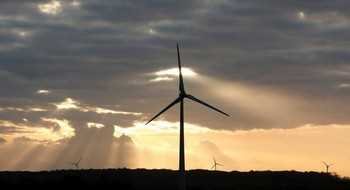 Over twice as tall as the Statue of Liberty and Elizabeth Tower (Big Ben), the world’s largest wind turbine will stand at more than 260 metres when measured from base to blade tip, with 220-metre diameter rotors, and generate enough clean energy for 16,000 European households.
Over twice as tall as the Statue of Liberty and Elizabeth Tower (Big Ben), the world’s largest wind turbine will stand at more than 260 metres when measured from base to blade tip, with 220-metre diameter rotors, and generate enough clean energy for 16,000 European households.
And it’s all in the name of efficiency, as larger blades make turbines more resilient to variations in wind speed, says GE Renewable Energy general manager Vincent Schellings, whose team is developing the immense wind turbines.
Schellings says: “From a technology perspective, it seems like a stretch. But we know it’s doable. The beauty of the turbine is that it gives an edge over the competition. There’s nothing like this. Not even close.”
The sheer size of GE’s turbine, called Haliade-X, means you can catch a lot of wind, which is good for energy production, but the downside is that you need the support structure to keep the rotor up in the wind, Schellings says.
“It’s kind of unfortunate that as you scale the rotor size, the turbine costs will go up quicker than the incremental yields you get from the larger rotor.”
He says the team solved this problem with software, using algorithms to process data from the turbine and offset the high forces the wind produces. “We use software to control the pitch of the turbine and keep it in the wind. It helps us keep the size and the weight of the support structure under control,” Schellings says.
The current largest operational turbine , developed as part of a joint venture between Mitsubishi Heavy Industries (MHI) and Vestas, has a rotor diameter of 164 metres and a 9.5-megawatt generator.
The next largest, developed by Gamesa and Areva, has a rotor diameter of 180 metres and a blade length of 88.4 metres, but its eight-megawatt generator is smaller in comparison to the MHI/Vesta turbine.
Supersized and energy efficient
The Haliade-X turbine will comprise of a 12-megawatt generator, sitting 150 metres above the sea, with each capable of producing 67 gigawatt-hours of energy per year, which is enough to power 16,000 households (based on wind conditions typical of the North Sea).
GE also claims each turbine will produce 45% more energy than any other offshore wind turbine available today.
The size of each would also allow operators to build wind farms with fewer turbines, lay fewer cables, and reduce construction, maintenance and other capital costs, GE says.
“This helps the customers when they are competing at auctions to build offshore farms and enter the lowest bid per kilowatt-hour,” says John Lavelle, CEO of GE Renewable Energy’s offshore wind division.
GE expects the first complete test turbine to be operational next year, with turbines shipped to customers in 2021.
However, GE engineers from across Europe and the United States are continually updating their designs and testing new technologies, such as 3D printing, which the company says may help reduce costs.
“We can’t limit our thinking,” Lavelle says. “What is our limit today may not be our limit in 2020.”
Offshore wind is getting stronger
The level of interest and investment in renewable energy has been rapidly increasing in recent years. Between 2004 and 2015 investment increased by more than six times to $286 billion. Renewables also attracted more than double the $130 billion committed to new coal and gas generation in 2015.
Offshore wind farms have been the focus of considerable innovation, outpacing development in the onshore wind sector. A chief reason for this is that offshore wind farms typically exceed expectations, outperforming their onshore counterparts.
For instance, Statoil’s Hywind floating wind farm, located off the coast of Aberdeenshire, Scotland, produced 65% of its maximum theoretical capacity in the months of November, December and January, according to EcoWatch .
In comparison, wind farms based onshore typically produced between 45% and 60% of their theoretical capacity during the same time period, EcoWatch said.
SOURCE: World Economic Forum
Hi! I am a robot. I just upvoted you! I found similar content that readers might be interested in:
https://www.weforum.org/agenda/2018/03/giant-offshore-turbine-wind-energy-haliade-x